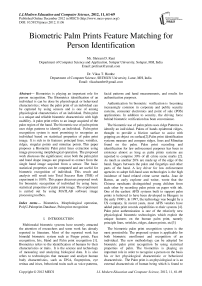Biometric Palm Prints Feature Matching for Person Identification
Автор: Shriram D. Raut, Vikas T. Humbe
Журнал: International Journal of Modern Education and Computer Science (IJMECS) @ijmecs
Статья в выпуске: 11 vol.4, 2012 года.
Бесплатный доступ
Biometrics is playing an important role for person recognition. The Biometrics identification of an individual is can be done by physiological or behavioral characteristics; where the palm print of an individual can be captured by using sensors and is one of among physiological characteristics of an individual. Palm print is a unique and reliable biometric characteristic with high usability. A palm print refers to an image acquired of the palm region of the hand. The biometric use of palm prints uses ridge patterns to identify an individual. Palm print recognition system is most promising to recognize an individual based on statistical properties of palm print image. It is rich in its features: principal lines, wrinkles, ridges, singular points and minutiae points. This paper proposes a Biometric Palm print lines extraction using image processing morphological operation. The proposed work discusses the significance; since both the palm print and hand shape images are proposed to extract from the single hand image acquired from a sensor. The basic statistical properties can be computed and are useful for biometric recognition of individual. This result and analysis will result into Total Success Rate (TSR) of experiment is 100%. This paper discusses proposed work for biometric recognition of individual by using basic statistical properties of palm print image. The experiment is carried out by using MATLAB software image processing toolbox.
Biometrics, Morphological operation, PolyU-Palmprint-Database, Palm print recognition
Короткий адрес: https://sciup.org/15014504
IDR: 15014504
Текст научной статьи Biometric Palm Prints Feature Matching for Person Identification
Published Online December 2012 in MECS
Multimodal biometric systems have recently attracted the attention of researchers and some work has already reported in literature. Most of the reported work has bimodal biometric system such as Finger prints, Face recognition, Iris, Hand and Palm print recognition [1]. Biometrics refers to the identification of humans by their characteristics or traits. It is the science and technology of measuring and analyzing biological data. It is also refers to technologies that measure and analyze human body characteristics, such as DNA, fingerprints, eye retinas and irises, behavioral traits such as voice patterns, facial patterns and hand measurements, and results for authentication purposes.
Authentication by biometric verification is becoming increasingly common in corporate and public security systems, consumer electronics and point of sale (POS) applications. In addition to security, the driving force behind biometric verification has been convenience.
The biometric use of palm prints uses ridge Patterns to identify an individual. Palms of hands epidermal ridges, thought to provide a friction surface to assist with gripping an object on surface[2].Palm print identification systems measure and compare ridges, lines and Minutiae found on the palm. Palm print recording and identification for law enforcement purposes has been in existence almost as long as palm prints systems are reported to comprise 30% of all crime scene marks [2]. As much as another 20% are made up of the edge of the hand, fingers between the palm and fingertips and other parts of the hand. A key driver for law enforcement agencies to adopt full-hand scan technologies is the high incidence of hand related crime scene marks. Joao de Barros, an early explorer and writer, wrote that the Chinese merchants distinguished young children from each other by recording palm prints on paper with ink. One of the earliest AFIS systems built to support palm prints is believed to have been developed in Hungary in the early 1990’s. In 1997, the technology was bought by a US company. In recent years, most AFIS vendors have added palm print records capabilities to their systems [4]. Palm print authentication is one of the relatively new physiological biometric technologies which exploit the unique features on the human palm print, namely principle lines, wrinkles, ridges, datum points, etc[3]
The biometric palm print recognition system is the most permissible. The proposed system is applicable for both biometric enrollment and recognition of an individual. The new methodology can be adopted for biometric palm print recognition by using statistical properties of palm. The biometrics is playing an important role in order to recognize a person on the basis his or her physiological characteristic or behavioral characteristic. The Palm print is an physiological or is an external characteristic of human being which is found to be unique and distinct from among every individual. The palm print has maximum region of interest; which makes researcher to study and carry experiments over palm print image such as palm print features- ridge, minutia and principal lines etc.
The proposed work discusses about the person identification on the basis of physiological characteristics of human being that is palm print recognition. Where a palm print is an image acquired from the palm region of the human hand. In our experiment we carried Image morphological experiments so as to highlight the principal lines of the palm print. Once these principal lines extracted from the image will be feature for the person identification. Then we have calculated the basic statistical properties of the palm print image; hence these calculated values are found to be distinct and unique for the number of experimented palm print image sample. Thus at the end we state the new approach for person identification on the basis of basic statistical values of palm print image.
-
II. METHODS FOR RECOGNITION
It can be used in the area of image processing which involves using algorithms to detect and isolate various desired portions or shapes (features) of a digitized image. Transforming the input data into the set of features is called feature extraction. There are three groups of marks which are used in palm print identification:
-
• Geometric features , such as the width, length and area of the palm. Geometric features are a coarse measurement and are relatively easily duplicated. In themselves they are not sufficiently distinct [3];
-
• Line features, principal lines and wrinkles . Line features identify the length, position, depth and size of the various lines and wrinkles on a palm. While wrinkles are highly distinctive and are not easily duplicated, principal lines may not be sufficiently distinctive to be a reliable identifier in themselves; and
-
• Point features or minutiae . Point features or minutiae are similar to fingerprint Minutiae and identify, amongst other features, ridges, ridge endings, bifurcation and dots [3].
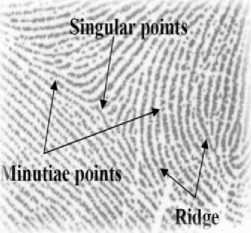
Fig 1 Palm print features
Palm creases and ridges are often superimposed which makes feature extraction difficult. An important issue in palm print recognition is to extract palm print features that can discriminate an individual from the other. There are two popular approaches to palm print recognition. One of the approaches is to transform palm print images into specific transformation domains [2].
-
III. STATISTICAL PROPERTIES
Statistics is the science of the collection, organization, and interpretation of data. It deals with all aspects of this, including the planning of data collection in terms of the design of surveys and experiments [5].
The basic steps of a statistical Experiment are:
-
1. Planning the research, including finding the number of replicates of the study, using the following information: Preliminary estimates regarding the size of treatment effects, alternative hypotheses, and the estimated experimental variability. Consideration of the selection of experimental subjects and the ethics of research is necessary. Statisticians recommend that experiments compare (at least) one new treatment with a standard treatment or control, to allow an unbiased estimate of the difference in treatment effects.
-
2. Design of experiments, using blocking to reduce the influence of confounding variables, and randomized assignment of treatments to subjects to allow unbiased estimates of treatment effects and experimental error. At this stage, the experimenters and statisticians write the experimental protocol that shall guide the performance of the experiment and that specifies the primary analysis of the experimental data.
-
3. Performing the experiment following the experimental protocol and analyzing the data following the experimental protocol.
-
4. Further examining the data set in secondary analyses, to suggest new hypotheses for future study.
-
5. Documenting and presenting the results of the study.
Statistics rarely give a simple Yes/No type answer to the question asked of them. Interpretation often comes down to the level of statistical significance applied to the numbers and often refers to the probability of a value accurately rejecting the null hypothesis (sometimes referred to as the p-value) [5]. Referring to statistical significance does not necessarily mean that the overall result is significant in real world terms. For example, in a large study of a drug it may be shown that the drug has a statistically significant but very small beneficial effect, such that the drug will be unlikely to help the patient in a noticeable way.
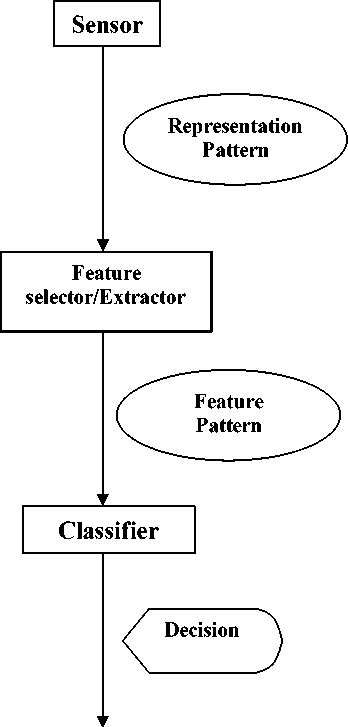
Fig.2 Pattern Classifier.
Figure 2 grossly oversimplifies the pattern classification procedure. Data may undergo several separate transformation stages before a final outcome is reached. Statistical approaches are either local or global statistical approaches. Local statistical approaches transform images into another domain and then divide the transformed images into several small regions [8].
Local statistics such as means and variances of each small region are calculated and regarded as features. Gabor, wavelets and Fourier transforms have been applied. The small regions are commonly square but some are elliptical and circular. To our knowledge, no one has yet investigated high order statistics for these approaches.
In addition to directly describing the local region by statistics, Wang et al. use histograms of local binary pattern as features. Global statistical approaches compute global statistical features directly from the whole transformed images
-
IV. FEATURE SELECTION
It can be used in the area of image processing which involves using algorithms to detect and isolate various desired portions or shapes (features) of a digitized image. Transforming the input data into the set of features is called feature extraction. If the features extracted are carefully chosen it is expected that the features set will extract the relevant information from the input data in order to perform the desired task using this reduced representation instead of the full size input.
Feature selection or feature extraction: selecting variables from the measured set that are appropriate for the task. These new variables may be obtained by a linear or nonlinear transformation of the original set (feature extraction). To some extent, the division of feature extraction and classification is artificial
In our work the feature selection is based on the statistical measurements of a palm for Palm print Recognition System. The proposed work discusses about to measure properties of image regions. There are various statistical measurements out of which part of our study and experiment are basic statistical properties of a palm image and are Area, Bounding box and centric.
The description is for the measurement of a set of properties for each connected component (object) in the binary image, BW. The image BW is a logical array; it can have any dimension
-
a. Area —
The Scalar can say an actual number of pixels in the region.
-
b. Bounding Box —
The smallest rectangle containing the region, a 1-by-Q *2 vector, where Q is the number of image dimensions: ndims(L), ndims(BW)
-
c. Centric:-
- It is 1-by-Q vector that specifies the center of mass of the region. Note that the first element of Centric is the horizontal coordinate (or x-coordinate) of the center of mass, and the second element is the vertical coordinate (or y-coordinate). All other elements of Centric are in order of dimension.
These basic statistical properties can be used to measure the statistical property of image region. The calculated values of palm lines extracted image can be useful for palm matching technique. The matching can be done by using basic statistical properties of palm and mostly useful on extracted palm lines image. Thus it can be very useful for palm matching technique with minimum time estimation.
-
V. PALM PRINT IMAGE DATABASE.
In order to carry image processing experiment; we require a digital image. The digital image can be inputted and related experiment can be carried and related results can be formed. So such image database is provided to the researcher to explore the related scientific research.
The Hong Kong Polytechnic University (PolyU) 2D_Palmprint Database [6] is an existing palm print image database made available world-wide to advance research in the area of biometrics palm print recognition system. The Biometric Research Centre (UGC/CRC) at The Hong Kong Polytechnic University [6] has developed palm print database. To advance research and to provide researchers working in the area palm print recognition a platform to compare the effectiveness of palm print recognition algorithms. They intend to publish our palm print database, making it freely available for academic, noncommercial uses. Palm print has proved to be one of the most unique and stable biometric characteristics. The palm prints refer to the image acquired of the palm region of the hand. The palm print image databases are made available world-wide to advance research and to provide researchers working in the area of palm print recognition system
Almost all the current palm print recognition techniques capture the two dimensional (2D) image of the palm surface and use it for feature extraction and matching. Although 2D palm print recognition can achieve high accuracy [6].
The PolyU 2D Palm print Database contains 7680 samples collected from 384 different palms. Twenty samples from each of these palms were collected in two separated sessions, where 10 samples were captured in each session, respectively.
The average time interval between the two sessions is one month. The all palm print images are of same size and same dimension palm print image such as 384 X 284 [6]. And each 2D palm print image was recorded in BMP format image file. The palm print images have a name sequence and can be interpreted as follows- e.g. - A palm print image name “PolyU_001_F.bmp” can be interpreted as the initiated word ‘PolyU’ is the copyright for the Polytechnic University of Hong Kong. Then followed ‘001’ indicate the subject enrollment number as it varies with person to person palm print image. The followed ‘F’ indicate the session enrollment that whether it is the First or Second. And finally the format ‘BMP’ of the image file.
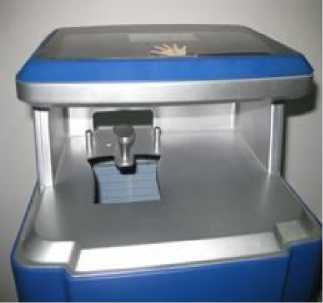
(a)
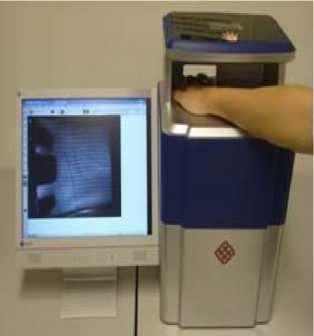
(b)
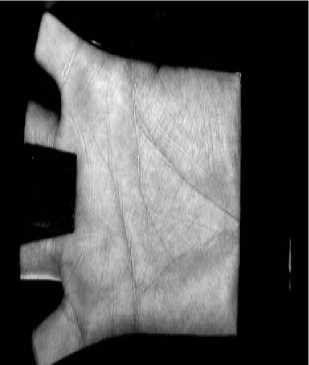
(c)
-
VI. EXPERIMENT AND RESULT
Pattern recognition is the assignment of a label to a given input value. An example of pattern recognition is classification, which attempts to assign each input value to one of a given set of classes. Palm print as a new member of pattern recognition and biometrics family, has attracted much of the research attention in the past decades. Palm print recognition is one of the relatively new physiological biometric technologies which exploit the unique features on the human palm print, namely principle lines, wrinkles, ridges, datum points, etc.
The methodology for the research to be carried out is based on statistical pattern recognition. As statistical pattern recognition is a term used to cover all stages of an investigation from problem formulation and data collection through to discrimination and classification, assessment of results and interpretation. The Experiment was performed over the palm Image taken from the database developed by the Hong Kong Polytechnic University (PolyU) palm print database.
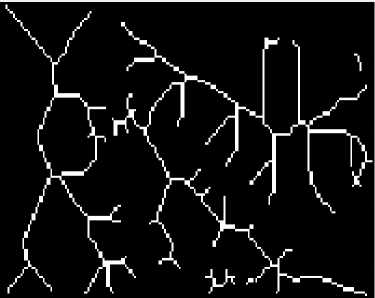

The palm print image after applying various morphological operations will successfully yield the principal lines of the palm print image. These are extracted features useful for Person identification.
These calculated values are distinct for each and every individual. So a palm matching can be done on the basis of individual basic statistical palm properties. And can be used to identify an individual. The testing image that’s basic statistical property such as area, bounding box and centric of palm line image and values is being calculated as we input the testing image. The corresponding one to one matching has to be done by comparing it with our already trained samples. The basic statistical properties are found to be distinct and unique for each and every palm print image sample.
The corresponding matching sample of testing palm sample will be got matched depending upon the similar statistical values of the Palm image. Hence the Biometric identification of individual can be done on the basis of its palm statistical properties such area, bounding box and centric of palm print image.

Fig.5 Compared palm line Images of PolyU_Database_001_F, 003_F, 005_F, 007_F, 009_F [5]
Table I. experimentally calculated statistical property values of the respective palm print image
|
Sr. No |
Name of Palm print Image |
Area |
Bounding Box |
Centric |
|
1 |
PolyU_001_F_01.bmp |
872 |
966 |
780.903 |
|
2 |
PolyU_003_F_01.bmp |
667 |
861 |
682.089 |
|
3 |
PolyU_005_F_01.bmp |
778 |
1744 |
1607.4 |
|
4 |
PolyU_007_F_01.bmp |
650 |
634 |
422.939 |
|
5 |
PolyU_009_F_01.bmp |
830 |
417 |
286.812 |
-
VII. RESULT
Line-based approaches are developed as an edge detector or use existing edge detection methods to extract palm lines. These lines are either matched directly or represented in other formats for matching. The edge operator to detect palm lines and is useful for the task of feature extraction.
-
• The area, bounding box and centric of palm print principal line image values is being calculated.
-
• The Perfect Match can be drawn by matching a testing palm print principal line image sample with the trained sample depending upon the area, bounding box and centric of palm print principal line image values.
-
• The FRR, FAR and TSR are as follows.
Table II. The resultant Total success rate, False Acceptance Rate,
FRR.
|
Using Statistical Property values |
|
|
FRR |
0.0% |
|
FAR |
0.0% |
|
TSR |
100% |
The edge detection methods that have been published mainly differ in the types of smoothing filters that are applied and the way the measures of edge strength are computed. As many edge detection methods rely on the computation of image gradients, they also differ in the types of filters used for computing gradient estimates in the x- and y-directions.
-
VIII. CONCLUSION
The biometric use of palm prints uses ridge patterns to identify an individual. Palms of hands epidermal ridges, thought to provide a friction surface to assist with gripping an object on surface. Palm print identification systems measure and compare ridges, lines and Minutiae found on the palm. Palm print is a unique and reliable biometric characteristic with high usability. The biometric use of palm prints uses ridge patterns to identify an individual. The introduction is followed by the problem definition; in which general concepts and methods of palm print recognition is introduced. Then some of the palm prints recognition methods and system are introduced.
The work discusses about the feature extraction and selection on the basis on the statistical measurements and properties of a palm print image for Biometric Palm print Recognition System. The proposed work discusses about the basic statistical properties of palm print image. The experimental work is performed by using MATLAB software; a software for image processing. The experiment is carried over the
PolyU_2D palm print image database. The statistical values are computed. The statistical property and their values are found to be distinct for the various palm print image sample from PolyU_2D palm print image database and were displayed in table 1.2. By using these values the image sample can be trained and their statistical values can be stored in database. The experimental result shows recognition rate of total success rate of 100% and false acceptance rate and false rejection rate 0%.
Список литературы Biometric Palm Prints Feature Matching for Person Identification
- Conference proceeding: Chin-Chuan Han, Hsu-Liang Cheng, and Kuo-Chin, “Personal Authentication Using Palm Print Features.” ACCV2002: The 5th Asian Conference on Computer Vision, 23–25 January 2002, Melbourne, Australia.
- Conference proceeding: Kuanquan Wang, Xiangqian Wu, “A Novel Approach of Palm-line Extraction”, Proceedings of the Third International Conference on Image and Graphics (ICIG’04), 0-7695-2244-0/04 © 2004 IEEE
- Journal: Ajay Kumar, David Zhang,” Personal authentication using multiple palm print representation”,0031-3203/2005 Pattern Recognition Society. Published by Elsevier Ltd.
- Journal: Hiroshi Nakajima, Koji Kobayash, Koichi Ito, Takafumi Aoki, Tatsuo Higuchi, “A PALMPRINT RECOGNITION ALGORITHM USING PHASE-BASED IMAGE MATCHING”, 1424404819/06©2006 IEEE.
- Book: Jamie DeCoster, “Introductory Statistics Notes”, August 1, 1998
- Harvey Motulsky, “Statistics Guide Statistical analyses for laboratory and clinical researcher”,1999-2005 GraphPad Software, Inc.
- C.C. Han, H.L. Cheng, C.L. Lin and K.C. Fan, “Personal authentication using palm-print features”, Pattern Recognition, vol. 36, no. 2, pp. 371-381, 2003.

